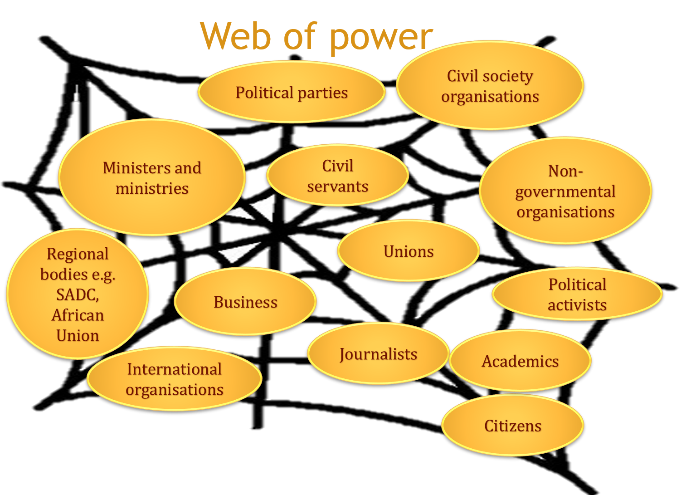Posts │ Wherever we are in the world, when researchers seek to engage policy makers and shift policy, we face many of the same challenges — often couched in the refrain: ‘Policy makers don’t listen to the evidence!’

In the 20 March Webinar Never mind the research piece! Communicating in policy environments, presenters unpacked a range of tools for opening the doors of communication between research and policy-making. However, none of the tools are enough without an analysis of power which can guide research communication. A power analysis will necessarily entail examining the ideologies of all the different policy stakeholders and the influence each stakeholder ideology exerts on policy-making. We also need to be honest about the ideology in which our own ideas about how to write policy are embedded.
As I discussed in the webinar, the terrain of power is not a simple hierarchy, but rather we can see it as a web. Different stakeholders (and their ideologies) may be pulling in different directions, or sometime the same directions, and each exerts power and influence over the other stakeholders. Because the web is flexible, its shape may change over time, as different stakeholders exert more or less power in the shifting external environment.
When planning a communications output, it is a good idea to map out the web of power at that moment, and work out whether for example, you want to target those who are exerting strong influence in the moment or whether you rather want to strengthen voices that are not being heard. At different times, it may be important to target specific stakeholders depending on a range of factors such as who is listening, who is exerting powerful influence at that moment, who will make good partnerships in communicating similar messages. A communications strategy ideally needs to assess the environment and target messages in a way that leverages more power.
When we understand this web of power, we can see that, in seeking to shape policy, researchers do not simply have to exert influence on policy makers, but can choose to communicate to all stakeholders in the web. Different communications tools (media) may be appropriate for reaching different stakeholders, so you will ideally only choose which communication medium to use once you have selected the stakeholders you want to target.
At the same time, when we understand that the web of power is underpinned by diverse ideologies, we can begin to think about the key messages that characterise the different ideologies. For example, business ideologies are likely to be characterised by messages about the economy and investment, while messages from non-governmental organisations may be characterised by language about people and their needs. The message packages are called ‘frames’.
When we frame our own messages, we need to be aware of the competing frames which are telling different stories to the story we want to tell. To be successful in telling our own stories, we need to find frames that highlight the benefits and opportunities created by this different way of seeing. It is not enough to simply tell a story that criticises other stories; in fact, directly taking on another story can be distracting and can make you seem contrary or combative (however, at other times, you may choose combative messages depending on context).
Message framing is a complex process and you should test a range of messages before you roll out your communications activities. In the information age in which we are all operating we are surrounded and bombarded by numerous messages, minute by minute. Each of these messages is likely to contain different ideologies, many of this messages will have been finely crafted to attract attention and exert influence. Finely crafting your own messages is not just about good storytelling, or fine writing, but about communicating cognisant of how your message will intersect with the web of powerful messages being simultaneously communicated to your chosen audience.
When researchers try to communicate without understanding the operations of power, they can often feel left out and frustrated. But by examining and working with the web of power and the underpinning ideologies, researchers can identify new opportunities, unexplored possibilities and refreshing new ways of communicating.
By Rebecca Pointer, Information and Communications Officer at the Institute for Poverty, Land and Agrarian Studies (PLAAS). This article is also available in Spanish.



